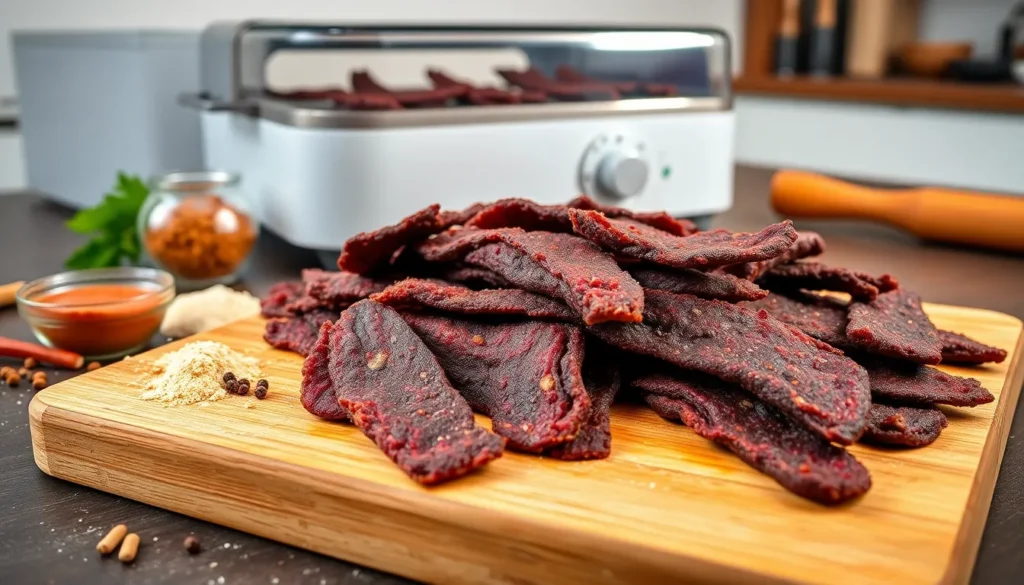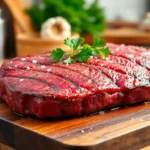We’ve all been there – craving a satisfying snack that won’t derail our keto goals. Store-bought jerky often comes loaded with hidden sugars and questionable preservatives that make it off-limits for low-carb lifestyles. That’s why we’re sharing our foolproof keto beef jerky recipe that delivers all the protein-packed satisfaction you want without the carb overload.
Making jerky at home isn’t just healthier – it’s surprisingly simple and incredibly rewarding. You’ll control every ingredient that goes into your batch while saving money compared to premium store brands. Our method uses basic pantry staples and transforms affordable cuts of beef into chewy strips of pure satisfaction.
This recipe creates tender jerky with bold flavors that’ll keep you satisfied between meals. Whether you’re meal prepping for busy weeks ahead or need grab-and-go snacks for outdoor adventures, homemade keto jerky checks all the boxes. Let’s jump into creating your new favorite high-protein snack.
Equipment Needed
Making our homemade keto beef jerky requires exact equipment to achieve the perfect texture and flavor. We need either a food dehydrator or an oven to remove moisture from the meat effectively.
Food Dehydrator serves as our top recommendation for creating consistent jerky. We prefer dehydrators because they maintain steady temperatures between 135°F and 145°F while circulating air evenly around the meat strips. Most models come with multiple trays that allow us to make large batches efficiently.
Conventional Oven works as an excellent alternative when we don’t have access to a dehydrator. We set our oven to its lowest temperature setting and prop the door slightly open to allow moisture to escape. This method requires more attention but produces equally delicious results.
Sharp Knife becomes essential for slicing our beef into uniform strips. We recommend using a chef’s knife or fillet knife that maintains its edge well. Consistent thickness ensures even drying throughout the jerky making process.
Cutting Board provides our stable work surface for meat preparation. We suggest using a large wooden or plastic board that gives us ample space to work with the beef safely.
Mixing Bowl allows us to combine our marinade ingredients thoroughly before adding the meat. We prefer using a glass or stainless steel bowl that won’t absorb flavors or odors.
Measuring Cups and Spoons help us maintain precise ratios for our keto-friendly seasonings and liquid ingredients. Accurate measurements ensure consistent flavor in every batch we create.
Wire Racks become necessary when using our oven method. We place these racks on baking sheets to elevate the meat strips and allow air circulation underneath for proper drying.
Ingredients
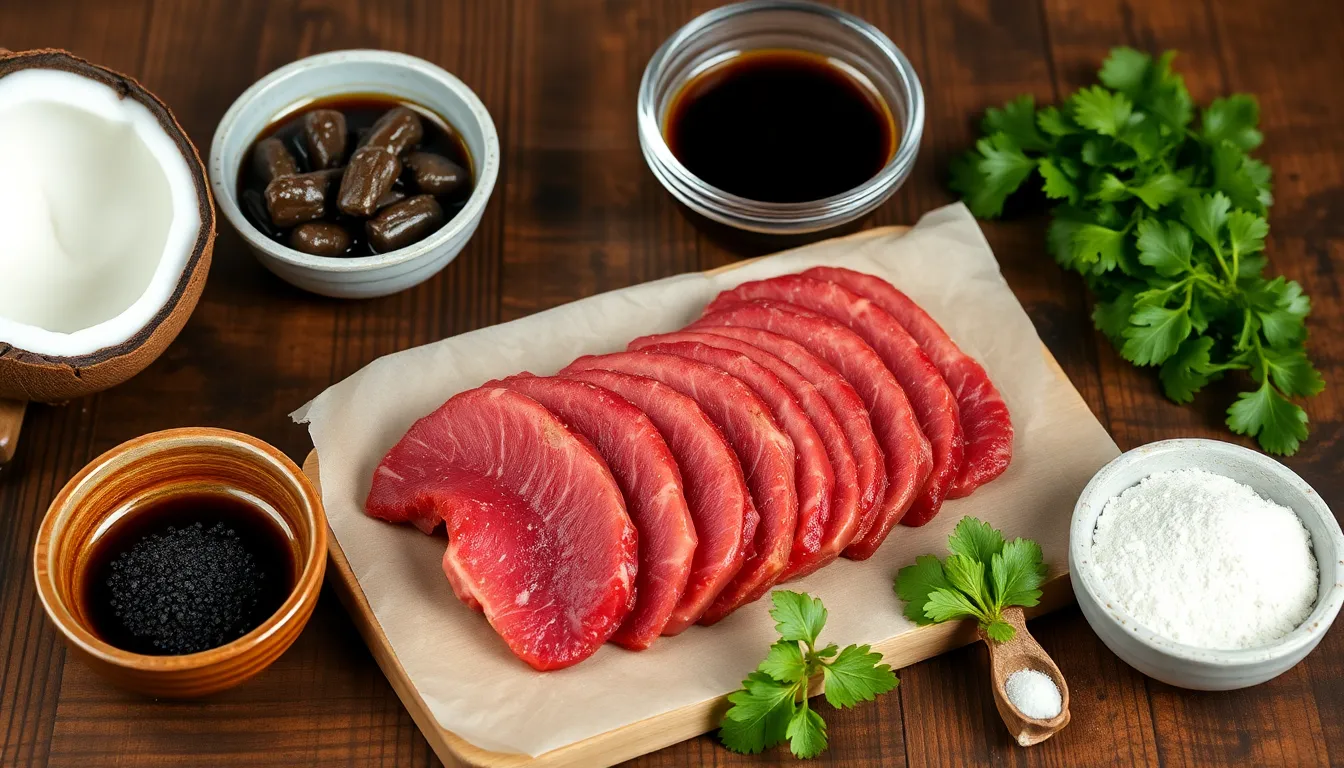
We’ve carefully selected each ingredient to ensure our keto beef jerky delivers maximum flavor while keeping carbs to an absolute minimum. These simple yet essential components work together to create a perfectly seasoned and preserved jerky that meets all your ketogenic requirements.
For the Beef
- 1 to 2 pounds of beef such as top sirloin flank steak or beef roast sliced thinly against the grain to about 1/4 inch thick
The key to exceptional jerky starts with choosing the right cut of meat. Top sirloin offers excellent flavor and tenderness while remaining budget friendly. Flank steak provides a leaner option with intense beefy taste that absorbs marinades beautifully. Beef roast cuts give you versatility and often better value when buying in larger quantities. Always slice against the grain to ensure your jerky has the perfect chewy texture without being tough.
For the Marinade
- 1/2 cup of coconut aminos or a soy sauce alternative
- 1 tablespoon of Worcestershire sauce (optional for extra depth)
- 1 tablespoon of Kosher salt
- 2 teaspoons of black pepper
- 1/4 teaspoon of garlic powder
- 1/4 teaspoon of onion powder (optional)
- Crushed red chili flakes for added heat (optional)
- Brown monk fruit sweetener or another zero calorie sweetener (optional)
Our marinade foundation relies on coconut aminos to provide that essential umami depth without the added sugars found in traditional soy sauce. Kosher salt acts as both a flavor enhancer and natural preservative while black pepper adds a subtle heat that complements the beef perfectly. Garlic powder and onion powder create layers of savory complexity that make each bite irresistible. The optional Worcestershire sauce intensifies the overall flavor profile while crushed red chili flakes let you customize the heat level to your preference. Brown monk fruit sweetener can balance any saltiness without compromising your ketogenic goals.
Prep Instructions
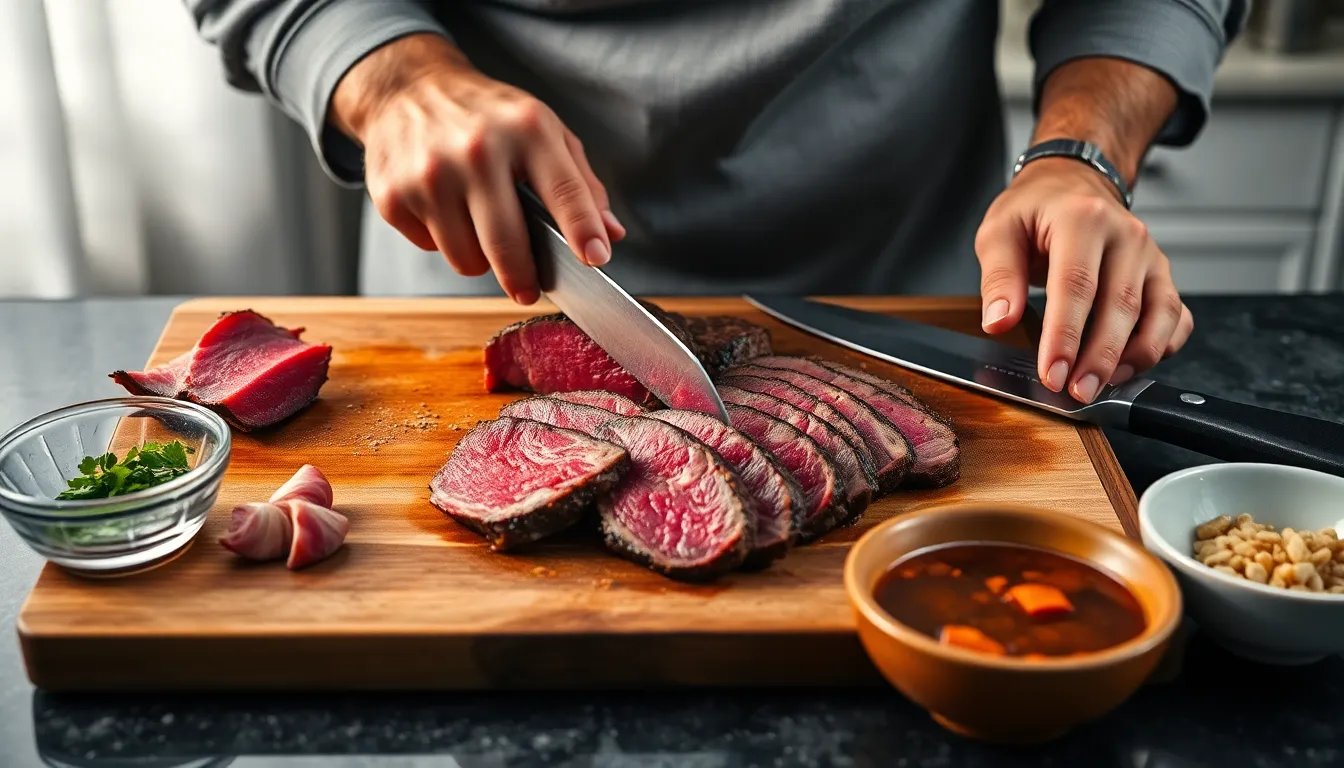
Proper preparation forms the foundation of exceptional keto beef jerky. We’ll walk through each critical step to ensure your jerky achieves perfect texture and flavor.
Selecting and Preparing the Meat
We start by choosing lean cuts like flank steak or sirloin for optimal results. A batch of 1½ pounds provides an ideal quantity for home preparation. Remove all visible fat and tendons completely to prevent spoilage and extend shelf life significantly.
Sharp knife work makes all the difference in achieving consistent texture. Slice the meat into thin strips approximately ¼ inch thick for even drying throughout. Cutting against the grain produces tender jerky while slicing with the grain creates chewier strips based on your preference.
Place the prepared meat strips into a large bowl or baking dish. This container should accommodate all strips with room for thorough marinade coverage. Uniform placement ensures each piece absorbs flavors evenly during the marinating process.
Making the Marinade
Our keto-friendly marinade eliminates sugar while maximizing flavor impact. Coconut aminos or soy sauce forms the base liquid component. Choose low sodium versions if you prefer controlling salt levels precisely.
| Marinade Component | Purpose | Keto Benefit |
|---|---|---|
| Coconut aminos | Umami base | Zero added sugars |
| Monk fruit sweetener | Optional sweetness | No carb impact |
| Garlic powder | Flavor enhancement | Minimal carbs |
| Black pepper | Spice depth | Virtually carb-free |
Mix coarse salt and black pepper with garlic powder and chili powder for the dry spice blend. Fresh garlic cloves add aromatic intensity when minced finely. Rosemary provides an earthy undertone that complements beef beautifully.
Monk fruit sweetener or brown sugar substitute can be added optionally but many keto dieters omit sweeteners entirely. Lemon juice brightens the overall flavor profile while remaining completely keto compliant.
Combine all marinade ingredients thoroughly before pouring over the meat strips. Ensure every piece receives complete coating by tossing gently with clean hands or tongs. Cover the container and refrigerate for 12 to 24 hours allowing flavors to penetrate deeply into the meat fibers.
Marinating Process
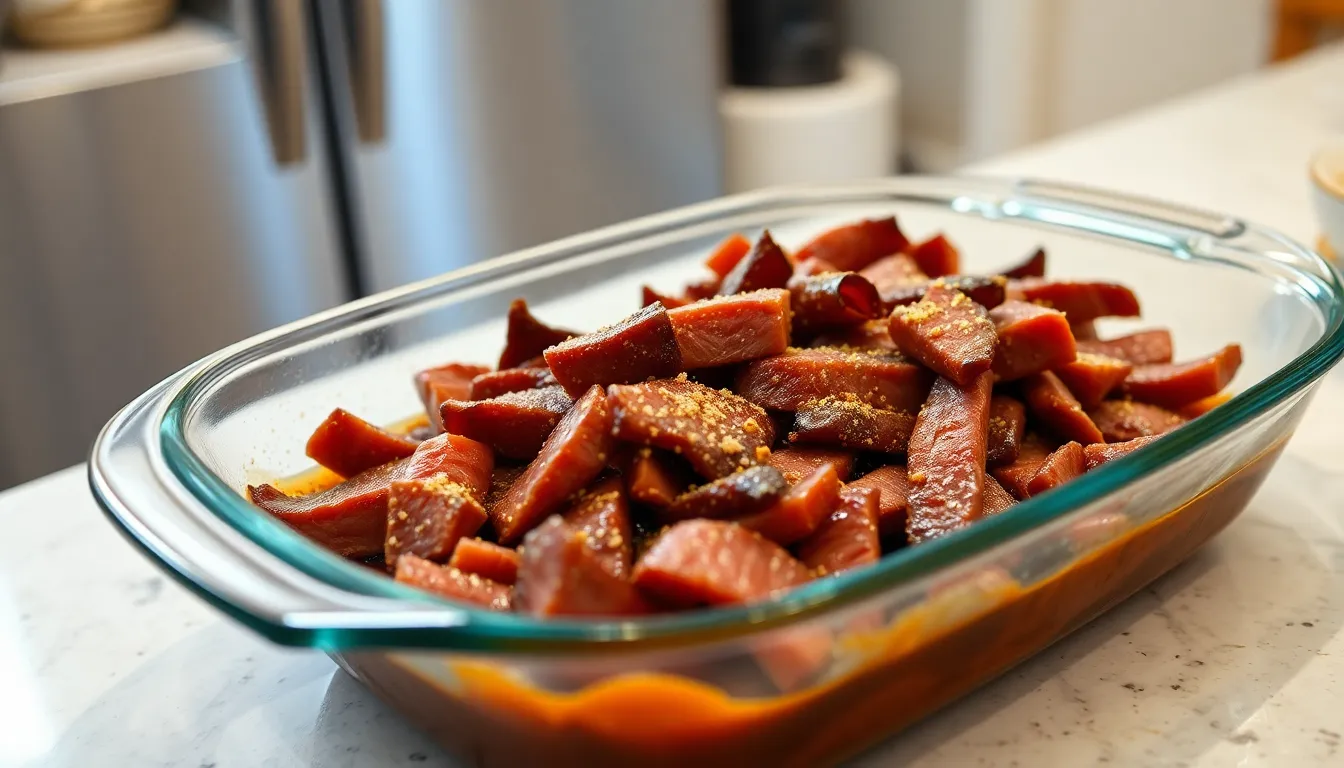
Now that we have our beef prepared and marinade ready, we move into the crucial marinating phase that transforms ordinary meat into flavorful keto jerky. This process requires patience but delivers exceptional results when done correctly.
We begin by placing our thinly sliced beef strips into a shallow glass or ceramic dish. Glass and ceramic containers work best because they won’t react with acidic marinade ingredients like metal containers might. Pour the prepared marinade over the beef strips, ensuring every piece gets completely coated. We recommend using your hands to massage the marinade into the meat, which helps the flavors penetrate more deeply.
The marinating time makes all the difference in our final product. We cover the dish and refrigerate the marinated beef for a minimum of 8 hours, though overnight marination produces superior results. During this extended period, the coconut aminos, garlic powder, and other seasonings work their way into the meat fibers, creating that bold flavor profile we’re after.
For those seeking maximum flavor intensity, we suggest marinating for up to 24 hours. This extended time allows the umami-rich ingredients like coconut aminos and Worcestershire sauce to fully saturate the beef. The longer marination also helps break down some of the meat’s toughness, resulting in more tender jerky.
| Marinating Timeline | Flavor Development | Texture Result |
|---|---|---|
| 4-6 hours | Light flavor | Firmer texture |
| 8-12 hours | Good flavor | Balanced texture |
| 12-24 hours | Deep flavor | Optimal tenderness |
While the beef marinates, we turn it occasionally to ensure even distribution of flavors. Some recipes suggest removing the marinated strips and pounding them gently between plastic wrap to achieve an even 1/8 inch thickness. This optional step promotes consistent drying and creates uniform jerky pieces.
The marinating vessel should remain covered throughout the process to prevent contamination and maintain moisture levels. We store the marinating beef on a middle shelf in the refrigerator where temperatures remain most consistent. This careful attention to the marinating process ensures our keto beef jerky develops rich, complex flavors without any of the sugars found in commercial varieties.
Dehydrating Instructions
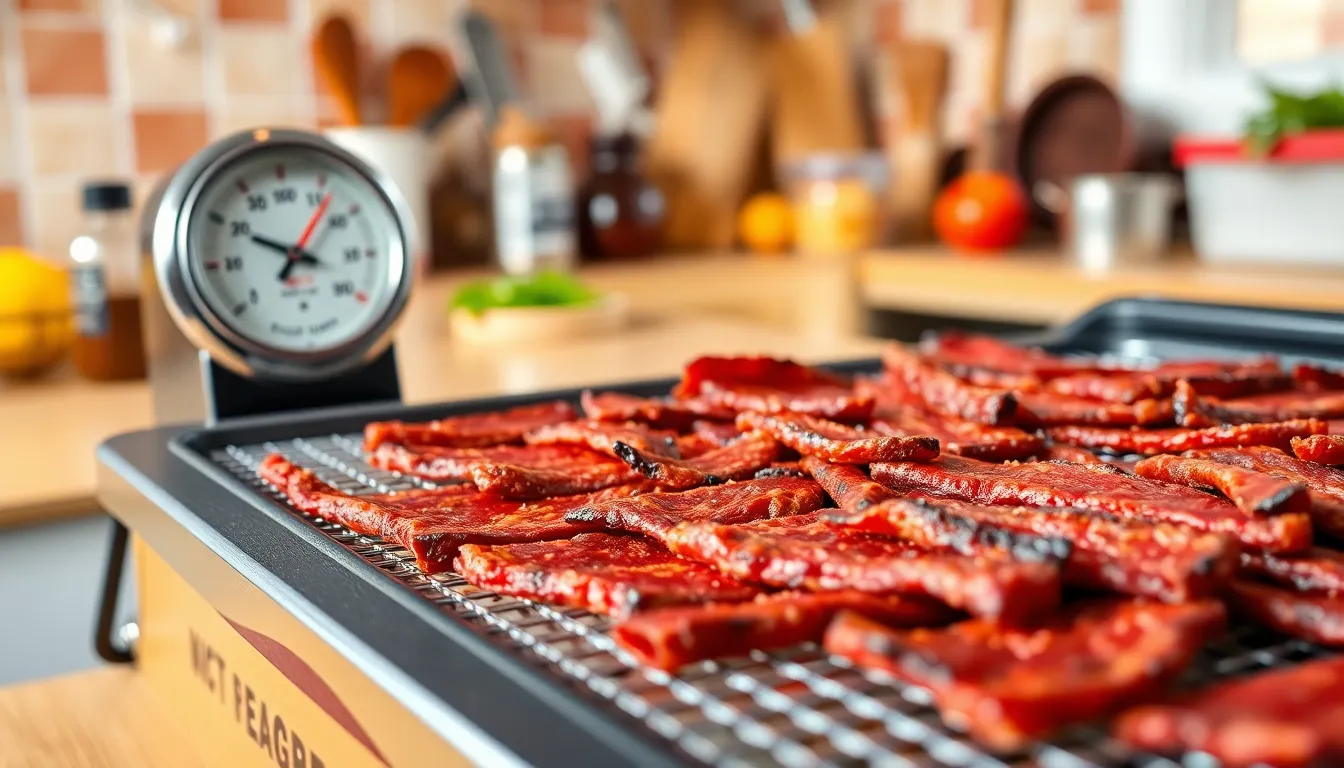
After marinating our beef strips for the optimal time we need to transform them into perfectly dried jerky. Both dehydrator and oven methods produce excellent results when we follow proper temperature and timing guidelines.
Using a Dehydrator
We recommend preheating our dehydrator to 160°F (71°C) if the unit allows temperature adjustment. Our marinated beef strips should be arranged in a single layer across the dehydrator trays without any pieces touching or overlapping. This spacing ensures proper air circulation around each strip for even drying.
The dehydrating process typically takes 4 to 8 hours depending on the thickness of our beef strips and desired texture. We rotate the trays halfway through the drying time to promote uniform dehydration across all levels. Our jerky reaches perfect doneness when it bends and cracks slightly but does not break completely in half.
Using an Oven
Our oven should be preheated to its lowest temperature setting which is usually around 175°F (79°C). We place a wire cooling rack on top of a large baking sheet to elevate the beef strips and allow air to circulate underneath. The marinated strips go on the rack in a single layer with space between each piece.
We prop the oven door open slightly using a wooden spoon handle to create ventilation and allow moisture to escape during the drying process. The beef typically requires 3 to 6 hours of drying time and we turn each strip once or twice throughout the process. Our jerky is ready when it achieves the same bend and crack test as the dehydrator method without breaking apart completely.
Testing for Doneness
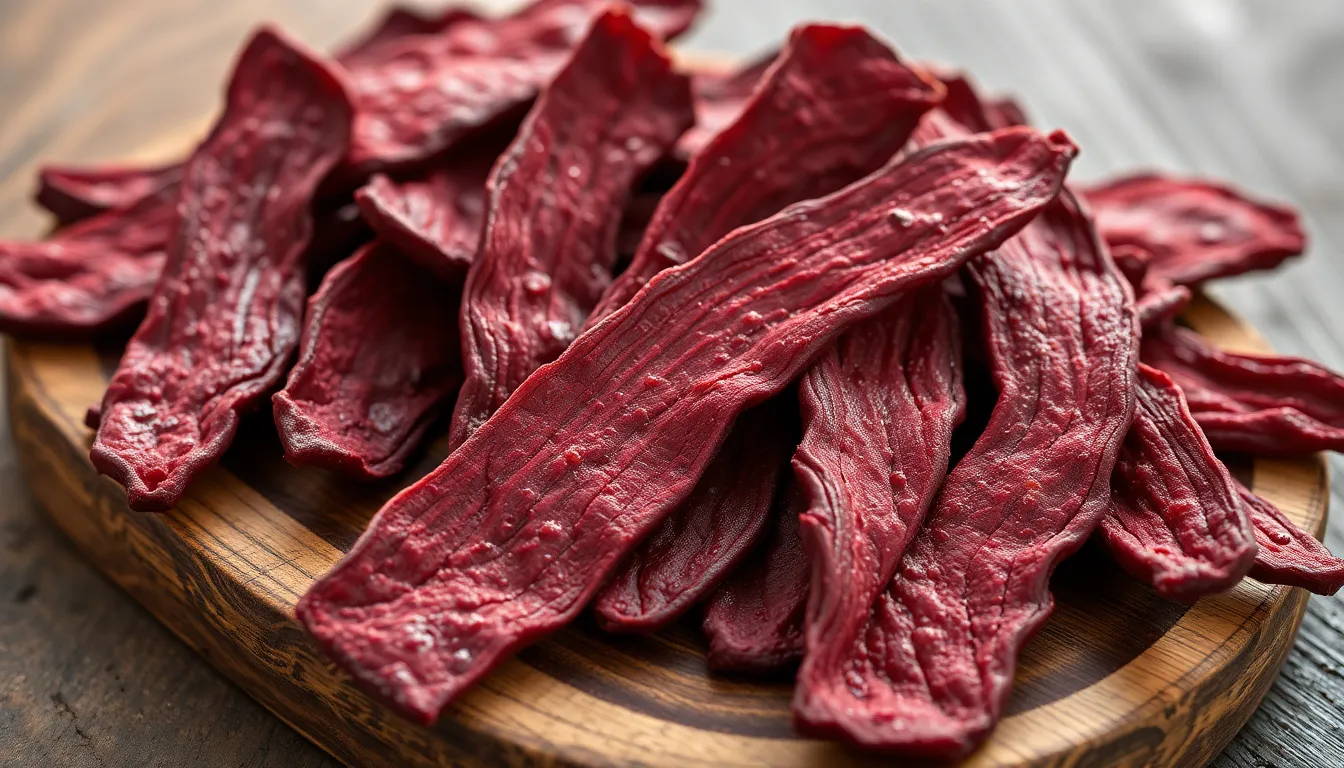
Determining when our keto beef jerky reaches perfect doneness requires understanding the key visual and tactile indicators that separate properly dried jerky from underdone or overdone results.
The ideal jerky texture strikes a delicate balance between dryness and flexibility. We should be able to bend a piece of jerky without it snapping in half immediately. When we apply gentle pressure to bend the strip it should crack slightly on the surface while maintaining its structural integrity. This cracking indicates proper moisture removal without crossing into brittle territory.
Our jerky should feel completely dry to the touch without any tacky or moist spots remaining on the surface. Running our fingers along the jerky strip should reveal a leathery texture that feels firm yet pliable. Any remaining moisture creates a breeding ground for bacteria and significantly reduces shelf life.
| Doneness Indicator | Properly Dried | Underdone | Overdone |
|---|---|---|---|
| Bend Test | Cracks but doesn’t break | Bends without cracking | Snaps immediately |
| Surface Feel | Dry and leathery | Tacky or moist | Brittle and hard |
| Color | Deep, even brown | Light or uneven | Dark brown to black |
| Storage Time | 7 days refrigerated | 1-2 days maximum | Becomes tough quickly |
Color provides another reliable doneness indicator for our keto beef jerky. Properly dried strips display a deep reddish-brown hue throughout with consistent coloring from edge to center. Lighter colored areas often signal insufficient drying time while excessively dark or blackened sections indicate over-dehydration.
We can perform the tear test by attempting to tear a cooled piece of jerky. Properly finished jerky requires deliberate effort to tear and should separate with clean edges rather than shredding into stringy pieces. This resistance indicates adequate moisture removal while preserving the meat’s protein structure.
Temperature plays a crucial role in our doneness assessment. We should always test jerky at room temperature since warm jerky feels more pliable than it actually is. Allow pieces to cool completely before conducting our final texture evaluation to ensure accurate results.
The finished jerky should maintain its shape when stored without becoming soggy or developing white spots that indicate moisture retention. Our properly dried keto beef jerky will keep its quality for up to seven days when stored in an airtight container in the refrigerator.
Storage Instructions
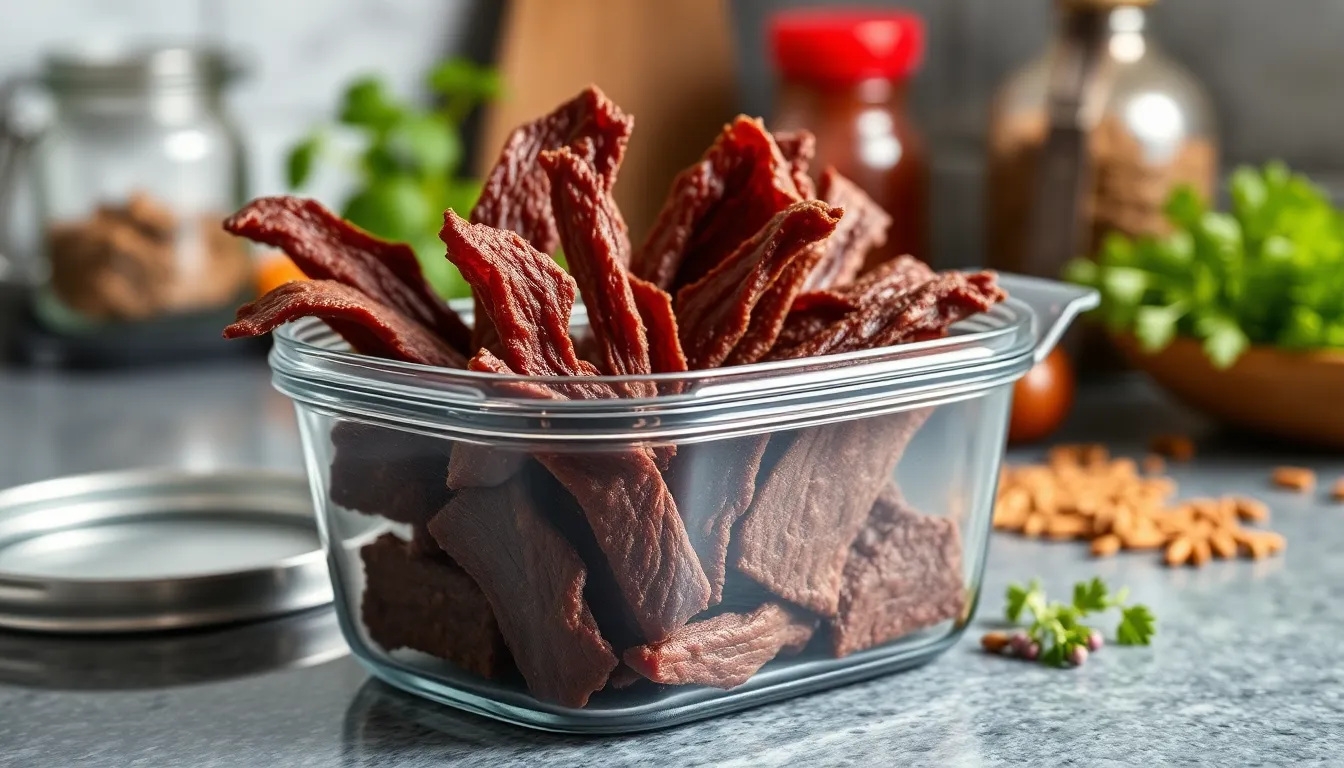
Proper storage is crucial for maintaining the quality and safety of your homemade keto beef jerky. We’ll walk you through the best practices to keep your jerky fresh and delicious.
Short-Term Storage
We recommend storing freshly made keto beef jerky in airtight containers to preserve its texture and flavor. Place the jerky in glass containers or resealable plastic bags and store them in the refrigerator immediately after cooling.
Your homemade jerky will maintain optimal quality for up to 4 days when refrigerated properly. Unlike commercial varieties, our homemade version retains more moisture and should be treated like cooked meat rather than shelf-stable products.
When packing jerky for travel or work, we suggest using insulated lunch boxes with ice packs. Consume the jerky within two hours when kept at room temperature to ensure food safety. This prevents bacterial growth that can occur when protein-rich foods remain in the temperature danger zone too long.
Long-Term Storage
For extended storage, we freeze our keto beef jerky in resealable freezer bags to maintain freshness for months. Layer the jerky pieces with wax paper between them to prevent sticking and make portioning easier later.
Properly frozen jerky maintains its quality for up to 3 months in the freezer. Label your freezer bags with the preparation date to track storage time effectively. Thaw only the portions you plan to consume within a few days.
| Storage Method | Duration | Temperature | Container Type |
|---|---|---|---|
| Refrigerated | 4 days | 35-40°F | Airtight containers |
| Frozen | 3 months | 0°F or below | Freezer bags with wax paper |
| Room temperature transport | 2 hours max | Below 90°F | Insulated containers with ice |
We avoid storing homemade jerky at room temperature for extended periods since it lacks the commercial preservatives needed for shelf stability. Your safety comes first, and refrigeration ensures we eliminate any risk of foodborne illness while preserving the jerky’s keto-friendly benefits.
Nutritional Information
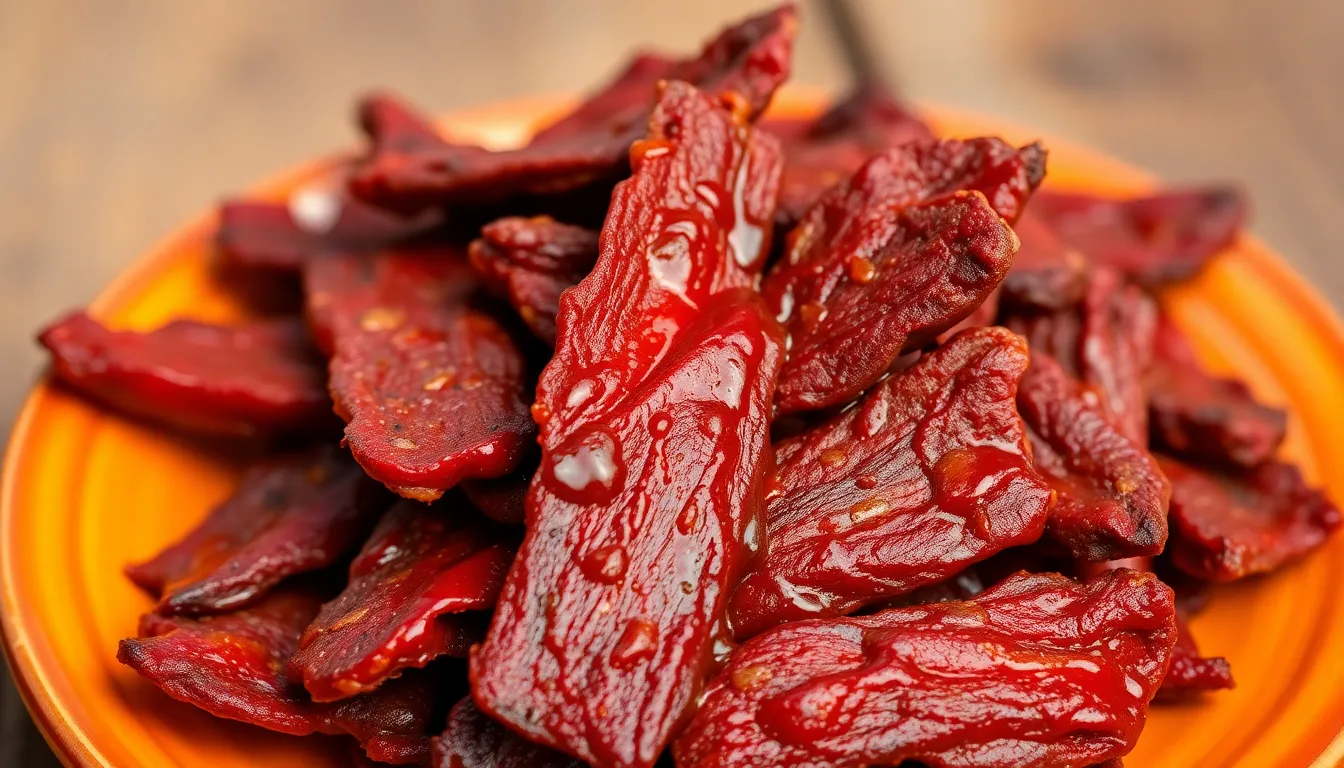
Our homemade keto beef jerky delivers exceptional nutritional value that perfectly aligns with ketogenic dietary requirements. Each 2-ounce serving provides substantial protein content while keeping carbohydrates minimal for sustained ketosis.
The macro breakdown demonstrates why this jerky ranks among the best keto-friendly snacks available:
| Nutrient | Amount per 2 oz Serving |
|---|---|
| Calories | 209 kcal |
| Protein | 29-30 grams |
| Total Carbs | 2.4-2.8 grams |
| Fiber | 0.5 grams |
| Net Carbs | 1.9-2.3 grams |
| Sugars | 0.3 grams |
| Fat | 7.7 grams |
| Saturated Fat | 2.8 grams |
| Sodium | 1200 mg |
| Potassium | 522 mg |
| Magnesium | 44 mg |
Protein dominates the nutritional profile with nearly 30 grams per serving making this jerky an excellent post-workout snack or meal replacement option. The high protein content supports muscle maintenance and provides lasting satiety that helps control appetite throughout the day.
Net carbohydrates remain under 2.5 grams per serving ensuring this jerky fits comfortably within most ketogenic daily carb limits. We achieve this low carb count by using coconut aminos instead of sugar-laden marinades found in commercial varieties.
Fat content sits at a moderate 7.7 grams per serving which allows flexibility in your daily fat intake goals. Since beef jerky naturally contains less fat than other keto staples we recommend pairing it with higher fat foods like nuts or cheese to maintain proper ketogenic ratios.
Sodium levels reach 1200mg per serving providing essential electrolytes that support hydration and muscle function during ketosis. This naturally occurring sodium from our sea salt marinade helps prevent the fatigue and cramping often associated with low-carb transitions.
Potassium and magnesium content further enhance the electrolyte profile with 522mg and 44mg respectively. These minerals support heart health and help maintain proper muscle function while following a ketogenic lifestyle.
The calorie density of 209 calories per 2-ounce serving makes portion control straightforward while delivering maximum nutritional impact. This concentrated nutrition profile makes our keto jerky ideal for travel meal prep or emergency snack situations where space and weight matter.
Tips for Perfect Keto Beef Jerky
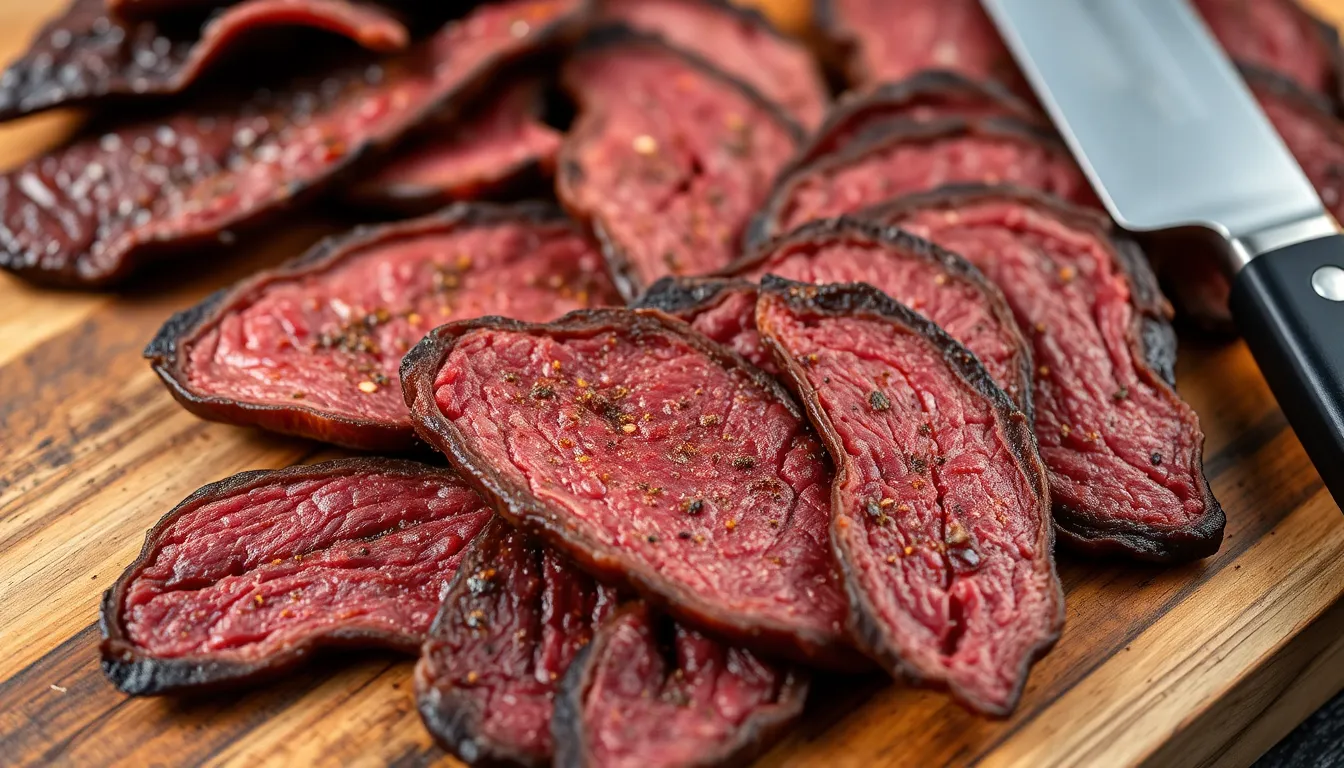
Now that we understand the dehydrating process and storage requirements, let’s explore the key factors that separate good jerky from exceptional jerky. These expert tips will help you create consistently delicious keto beef jerky every time.
Meat Selection Tips
We recommend choosing lean cuts for the best jerky results, with flank steak, top sirloin, bottom round, or round eye roast delivering optimal texture and flavor. Fatty cuts should be avoided entirely since excess fat causes spoilage and creates unpleasant off-flavors during the dehydration process.
Our preferred method involves freezing the beef for about one hour before slicing, which makes achieving uniform thickness much easier. Slice the meat against the grain to ensure tender jerky that’s easy to chew after dehydration.
Consistent thickness matters significantly for even drying, so we always cut our beef slices to approximately 1/4 inch thick. This measurement ensures uniform dehydration and prevents some pieces from becoming over-dried while others remain undercooked.
| Cut Type | Fat Content | Tenderness | Best Use |
|---|---|---|---|
| Flank Steak | Low | High | Premium jerky |
| Top Sirloin | Low | High | Daily snacking |
| Bottom Round | Very Low | Medium | Budget-friendly |
| Round Eye Roast | Very Low | Medium | Batch preparation |
Flavor Variations
Classic spice blends form the foundation of exceptional keto jerky, with salt, black pepper, garlic powder, onion powder, chili powder, and smoked paprika creating robust flavor profiles. We use these seasonings as our base and build complexity from there.
Sugar substitutes allow us to achieve sweet-savory profiles without compromising ketogenic compliance, with monk fruit sweetener or brown monk fruit sugar providing natural sweetness. These alternatives deliver the familiar jerky taste without adding carbohydrates.
Heat enthusiasts can incorporate crushed red pepper flakes or sriracha to create spicy variations that complement the beef’s natural flavors. Start with small amounts and adjust to your preferred heat level.
Umami enhancement comes from coconut aminos or sugar-free soy sauce, which deepen the savory characteristics without adding unwanted carbs. These ingredients create that satisfying meaty flavor we associate with premium jerky.
We always double-check that our marinade and seasoning ingredients remain sugar-free to maintain strict keto compliance. Salt and spice levels can be adjusted according to personal preference, while those following carnivore diets should omit sugar substitutes entirely and rely solely on salt and spices.
Troubleshooting Common Issues
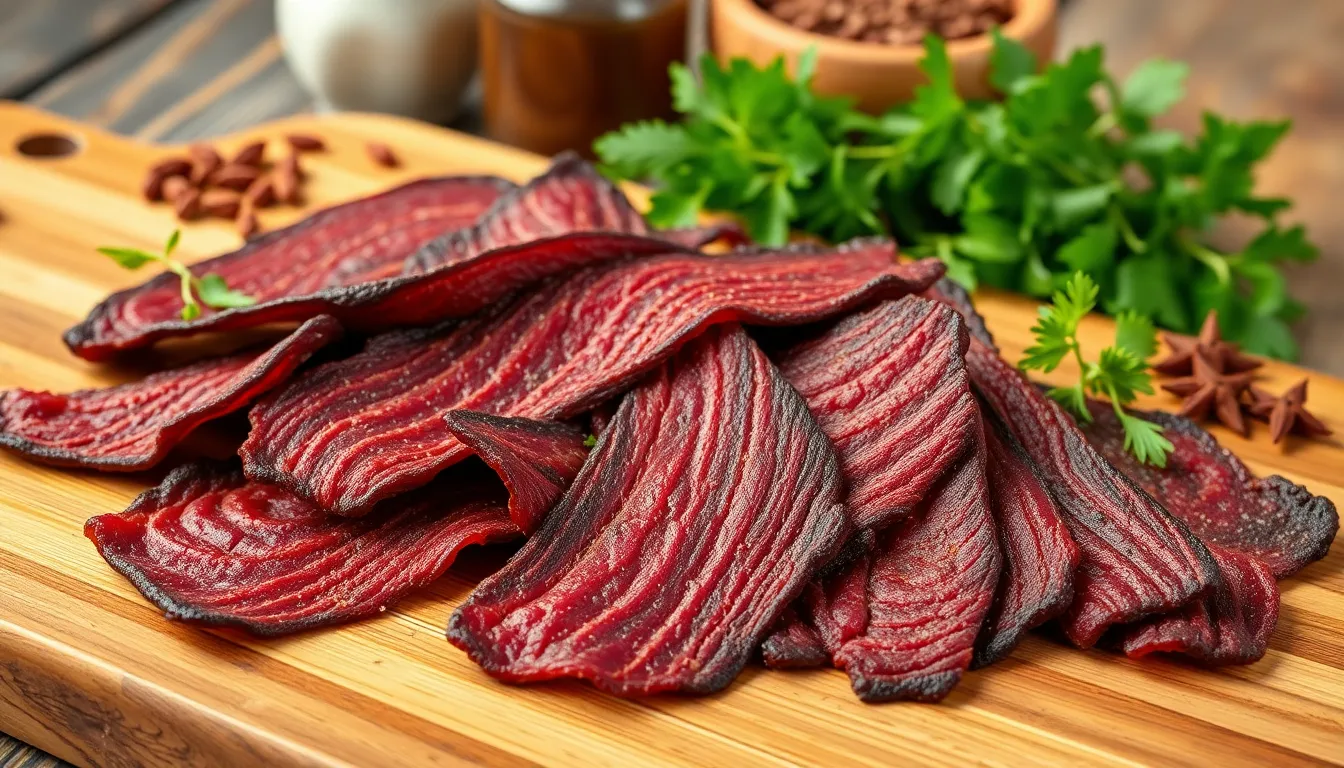
Creating perfect keto beef jerky requires attention to detail, and we often encounter exact challenges during the process. Understanding these common issues helps us achieve consistent results every time we make this protein-packed snack.
Jerky texture problems frequently occur when we slice the meat incorrectly or miscalculate drying times. When our jerky turns out too tough or hard, we need to slice thinner strips and extend the marinating time to tenderize the meat properly. Checking the texture periodically during the drying process prevents over-drying, which creates an unpleasantly chewy result. We recommend testing a piece every hour during the final stages of dehydration.
Excessive saltiness can overpower the other flavors in our jerky. Reducing the sea salt content or switching from regular soy sauce to coconut aminos provides a less salty alternative while maintaining the umami depth we desire. Coconut aminos offer natural sweetness without adding carbohydrates, making them ideal for ketogenic recipes.
Flavor intensity issues occur when we rush the marinating process or use insufficient seasoning. Increasing garlic, liquid smoke, or other spices in our marinade creates more robust flavors. Extended marinating time up to 24 hours allows the seasonings to penetrate deeper into the meat fibers, resulting in more flavorful jerky throughout each piece.
Storage and spoilage concerns arise when our jerky retains too much moisture. Ensuring complete drying while maintaining flexibility prevents premature spoilage. Our jerky should bend without breaking but feel completely dry to the touch. Storing finished jerky in airtight containers and refrigerating immediately extends shelf life to seven days while preserving quality.
Slicing difficulties can frustrate even experienced home cooks. Freezing the beef for at least one hour before slicing makes the process significantly easier and produces more uniform strips. Alternatively, asking our butcher to thin slice the meat saves time and ensures consistent thickness throughout the batch.
Conclusion
Making your own keto beef jerky isn’t just about saving money – it’s about taking control of what goes into your body. We’ve shown you how to create a protein-packed snack that fits perfectly into your ketogenic lifestyle without any hidden sugars or unwanted additives.
The process might seem involved at first but once you’ve made your first batch you’ll realize how straightforward it really is. From selecting the right cut of beef to achieving that perfect chewy texture your homemade jerky will outshine any store-bought alternative.
We encourage you to experiment with different spice combinations and find your signature flavor profile. Whether you’re meal prepping for the week ahead or need a reliable travel snack this keto beef jerky recipe will become an essential part of your low-carb arsenal.
Frequently Asked Questions
What makes this beef jerky recipe keto-friendly?
This recipe uses coconut aminos or soy sauce instead of sugar-laden marinades, includes keto-approved seasonings, and optional sugar-free sweeteners like monk fruit. Each 2-ounce serving contains only 2.4-2.8 grams of total carbohydrates and 0.3 grams of sugar, making it perfect for maintaining ketosis while providing 29-30 grams of high-quality protein.
What equipment do I need to make homemade beef jerky?
You’ll need either a food dehydrator (recommended) or a conventional oven, a sharp knife for slicing, cutting board, mixing bowl, measuring cups and spoons, and wire racks if using the oven method. A food dehydrator provides better temperature control and air circulation, but an oven set to its lowest temperature with the door propped open works as an alternative.
Which cuts of beef work best for jerky?
Lean cuts like flank steak, top sirloin, bottom round, or round eye roast are ideal. These cuts have minimal fat content, which prevents spoilage and ensures better texture. Remove all visible fat before slicing, and cut the meat against the grain into uniform strips approximately 1/4 inch thick for even drying.
How long should I marinate the beef?
Marinate the beef for a minimum of 8 hours, though overnight (12-24 hours) yields the best results. The longer marinating time allows the umami-rich ingredients to penetrate deeply, tenderizing the meat and intensifying the flavor. Use glass or ceramic containers and turn the beef occasionally for even distribution.
How do I know when the jerky is properly dried?
Properly dried jerky should bend without snapping completely in half, feel dry to the touch, and have a deep, even brown color. Perform the bend test at room temperature – it should crack slightly but not break. The surface should be firm with no moisture when pressed gently.
How should I store homemade beef jerky?
Store homemade jerky in airtight containers in the refrigerator for up to 4 days for short-term storage. For longer storage, freeze in resealable bags with wax paper between pieces for up to 3 months. Never store at room temperature for extended periods, as homemade jerky lacks commercial preservatives.
What’s the difference between using a dehydrator vs. an oven?
A dehydrator maintains steady temperatures (160°F/71°C) and provides even air circulation, taking 4-8 hours. An oven requires the lowest setting (around 175°F/79°C) with the door propped open for moisture escape, taking 3-6 hours but requiring more attention. Dehydrators are more efficient for batch preparation.
Can I customize the flavor of this keto jerky recipe?
Yes! You can adjust the spice levels, add different seasonings like smoked paprika or cayenne pepper, or experiment with sugar-free sweeteners for sweet-savory profiles. The base marinade of coconut aminos, salt, and spices can be modified while maintaining keto compliance by avoiding any sugar-containing ingredients.

